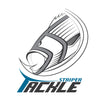Best Tackle for Fall and Winter Striper Fishing on Southeastern Lakes
As the crisp air settles over the southeastern lakes, it's time to gear up for some prime striper fishing. Fall and winter bring unique opportunities to hook into these powerful fish, and having the right striper tackle can make all the difference. Let's dive into the essentials to ensure you're well-prepared for a successful outing.
Rods: Opt for a medium-heavy to heavy-action rod, around 7 to 8 feet in length. This setup provides the backbone needed to handle hefty stripers while offering the versatility needed for both deep presentations using a down line as well as surface presentations using planer boards or flat line techniques.
Reels: Pair your rod with a quality spinning reel in the 3000 to 4000 size range. A smooth drag system is crucial to manage those powerful runs without risking a break-off.
Alternatively, a high capacity, low-profile baitcaster such as an Okuma Coldwater Line Counter works well for jigging and trolling.
Line: A 15 to 30-pound braided line is ideal for its strength and sensitivity. Complement this with a 10 to 20-pound fluorocarbon leader to maintain stealth, especially in clear water conditions.
Lures and Baits:
- Jigging Spoons: Silver or gold spoons weighing between 1/2 to 1 ounces are excellent for vertical jigging, mimicking the flash of distressed baitfish. StriperTackle Jigging Spoons or Captain Mack’s Super Spoons are great for vertical jigging.
- Swimbaits: Paddle-tail swimbaits ranging from 3 to 5 inches, rigged on a 1/8 to ½ -ounce jighead, effectively imitate shad and herring. A slow retrieve often proves enticing in cooler waters. StriperTackle Ultra Pro Swim Bait Heads are an option here.
- Topwater Lures: In early fall, when stripers are actively chasing bait near the surface, lures like pencil poppers and walking baits can trigger explosive strikes.
- Live Bait: Blue back herring, trout or shard are prime choices. Utilize a Carolina rig or downline with a 1 to 2-ounce sinker to present live bait at the desired depth. You can use StriperTackle Pro Pencil Weights or Egg Weights as an option.
- Planer Boards: Use a planer board with no weight up to ¼ oz of weight to present to baits closer to the surface. Captain Mack's Perfect Planer Boards are a good option.
- Umbrella Rigs: Effective for trolling or casting, these rigs allow multiple swimbaits to be fished simultaneously, simulating a school of baitfish. These are best used when stripers are aggressively feeding.
Additional Gear:
- Circle Hooks: Sizes #2 to 3/0 are ideal for live bait fishing, promoting better hook sets and facilitating catch-and-release practices.
- Swivels and Snaps: Use strong, high-quality swivels to prevent line twist when trolling or using umbrella rigs.
- Electronics: A reliable fish finder and GPS unit are invaluable for locating bait schools and tracking striper movements.
- Landing Net: A deep, rubber-coated net ensures safe handling of your catch, preserving the fish's protective slime layer.
Seasonal Tips:
- Early Fall: Focus on topwater action during the morning and evening hours when stripers are feeding aggressively near the surface.
- Late Fall into Winter: As water temperatures drop, stripers tend to move deeper. Vertical jigging with spoons or presenting live bait near drop-offs and submerged structures can yield excellent results.
Remember, each day on the water presents new challenges and learning experiences. Stay adaptable, observe the conditions, and adjust your tactics accordingly. With the right tackle and approach, you're well on your way to creating memorable striper fishing adventures this fall and winter. Tight lines!
